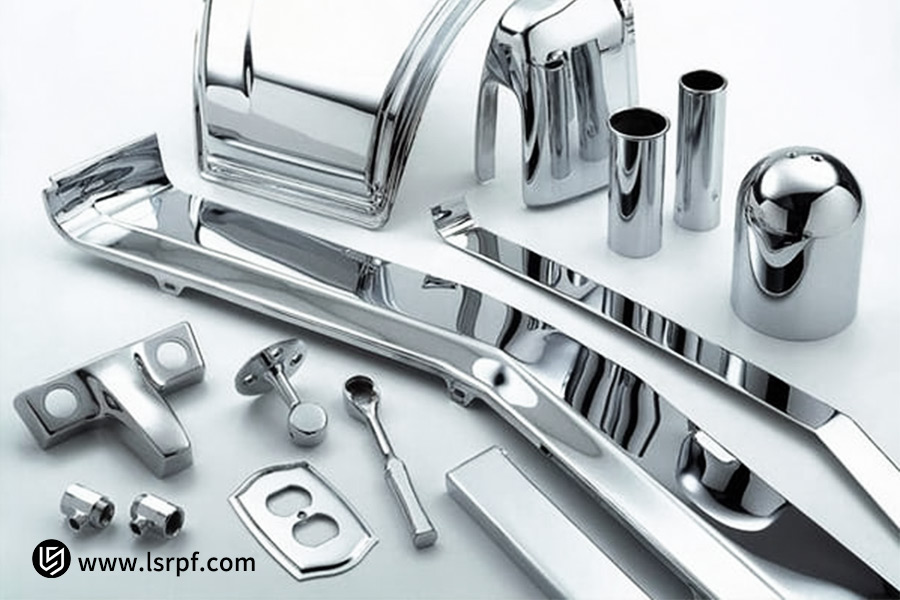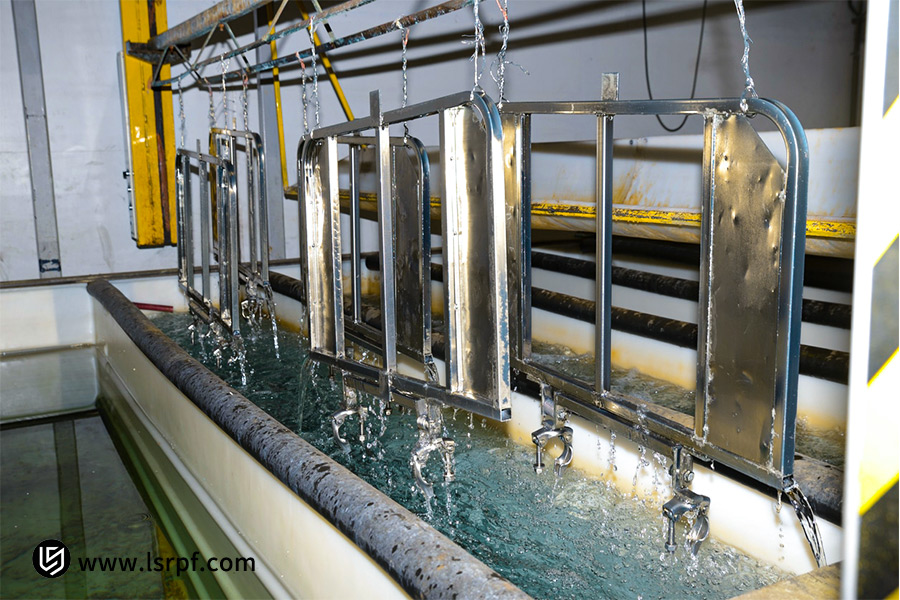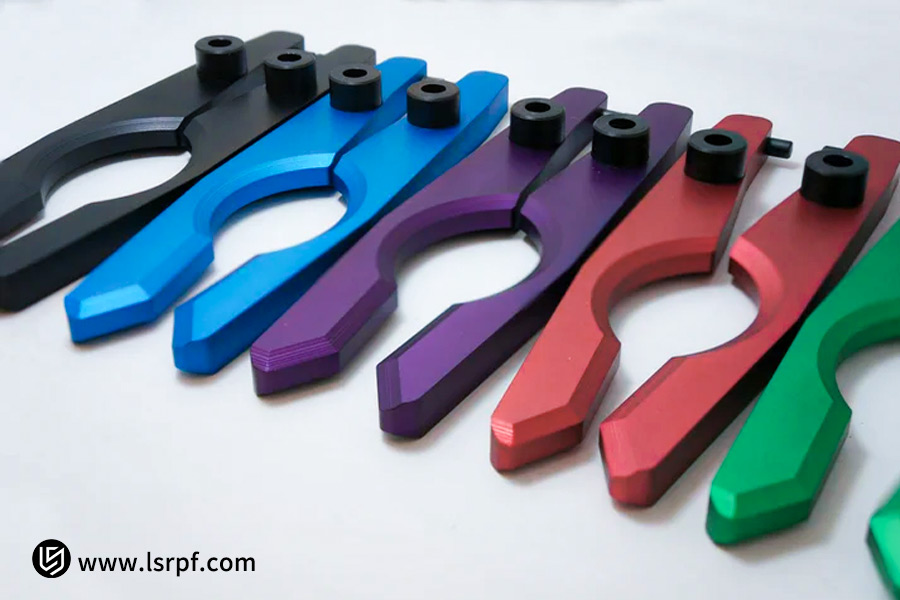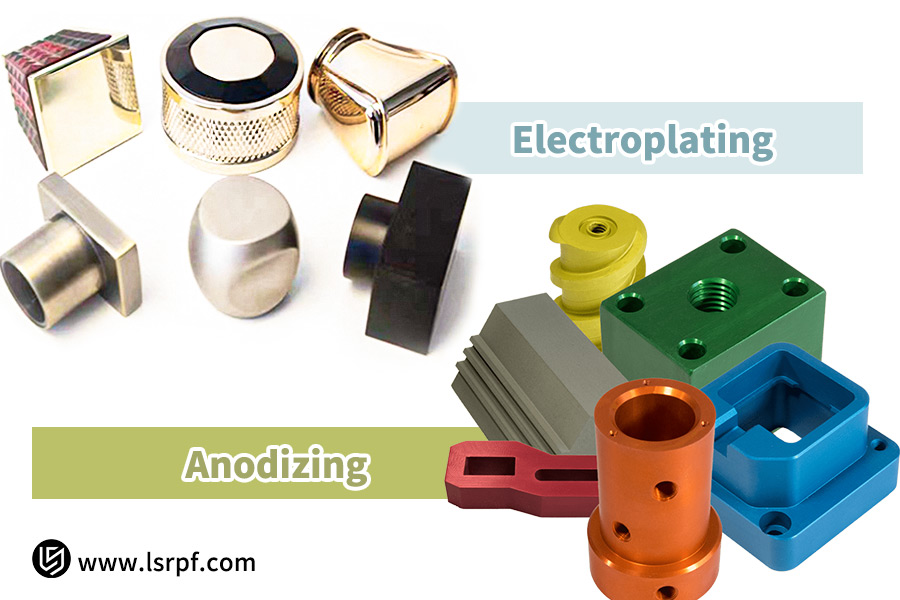In the field of precision manufacturing, anodizing and electroplating are two popular surface finishing technologies, which tend to pose a difficult choice to decision-makers. The choice has direct effects on a product's corrosion resistance, conductivity, appearance, and finally, price, making it an important determinant to product competitiveness.
Fundamentally, anodizing creates an oxide strengthening layer on the surface of metals like aluminum, which integrates perfectly into the substrate and offers better wear and corrosion resistance. Electroplating, on the other hand, deposits a layer of another metal onto the substrate, primarily to alter its color, enhance conductance, or provide extra protection.
To help you make the most suitable choice, LS Manufacturing will outline the ten main differences between the two for you. Based on our extensive industry experience, we will provide you with scientific selection techniques and high-quality processing services based on your specific application conditions. To save you time, here's a quick overview of the core conclusions.
Anodizing vs. Electroplating: Key Differences Quick Reference
| Feature Dimension | Anodizing | Electroplating |
| Processing Materials | Primarily valve metals such as aluminum and titanium. | Virtually all metals (such as steel, copper, and aluminum alloys); Certain non-metals (such as plastics). |
| Layer Properties | Creates an integral conversion coating within the substrate. | Individual deposited layer, independent of substrate material. |
| Main Purpose | Improves corrosion resistance and abrasion resistance, insulates, and colors. | Changes surface properties (weldability and conductivity),decorates, protects, to some extent. |
| Appearance | Can be dull to reflective, with deep colors (to be colored). | Normal metallic luster (e.g., chromium, nickel, gold, and silver). |
| Conductivity | Non-conductive (excellent insulator) | Excellent conductivity |
| Dimensional Impact | The film layer increases the size of the workpiece. | The coating is very thin and does not induce significant dimensional change. |
| Adhesion | Highly adhesive (microporous structure, chemically bonded on the substrate). | Good, but with risk of interlayer delamination. |
| Environmental and Cost | Relatively environmentally friendly with medium cost. | Heavy metals are involved, there are tight environmental specifications, and prices differ based on the metal. |
The key distinction between anodizing and electroplating is the use of a self-forming oxide film as opposed to the deposition of a foreign metal coating:
- Choosing anodizing: Maximum protection (for aluminum/titanium parts requiring excellent wear and corrosion resistance); Insulation needs (requiring an insulating surface); Special appearance (requiring a particular color by dyeing).
- Choosing electroplating: Functional change (requiring high conductivity or solderability); Aesthetic effects (requiring a normal metallic look, e.g., chrome's shining white or gold's luxurious feel); Compatibility with a variety of substrates (achieving metallization effects in non-aluminum substrates such as steel and plastic).
The final decision has to be made based on all product materials, application conditions, performance requirements, and budget in an overall manner. LS Manufacturing can provide you with expert technical evaluations and customized solutions.
Why Trust This Guide? Practical Experience From LS Manufacturing Experts
The advice we offer here is not textbook-based, but rather the culmination of over a decade of LS Manufacturing's long history of working with surface finishing. Not only are we working with finely intricate parts made up of mixed metals such as aluminum, steel, and titanium, but also with the distinctive concerns our customers have in store regarding corrosion resistance, conductivity, aesthetics, and affordability.
For example, LS Manufacturing assisted one medical device firm in evaluating anodizing and electroplating options for their aluminum case. Ultimately, our proprietary anodizing process enabled us to achieve a salt spray test life exceeding 1,000 hours, more than ten times the industry specification, with the specified biocompatibility and flat black finish.
In a second consumer electronics use, LS Manufacturing used highly selective electroplating technology to yield micron-level, localized gold plating on very small connectors, essentially solving signal transmission stability and plug-in reliability issues.
These real project experiences have enabled LS Manufacturing to intimately understand the microscopic behavior of processes and how they impact product success. We're providing this information and techniques, validated in full-scale production, to provide the most helpful decision-making support.
Anodizing And Electroplating: What Are The Fundamental Differences?
Anodizing and electroplating are the two most traditional surface finishing technologies in the precision manufacturing industry. But they have different underlying principles, which completely determine their different performance and applications. In fact, their most important differences reside in the following:
1. Core Principle: Conversion and Coating
Anodizing is a transformation process which "spins out of a cocoon into a butterfly." With valve metals such as aluminum and titanium being the anode, an electric current is compelled through a selected electrolyte, oxidizing metal atoms at the substrate surface to form a dense, porous film of aluminum oxide (such as Al₂O₃). The film is not a foreign substance but emerges from within the substrate and forms a very strong bond with the substrate.
Electroplating is a plating method that "deposits a coating." The workpiece is the cathode and is submerged in an electrolyte containing target metal ions (e.g., nickel, chromium, gold). The current decreases the metal ions and deposits them onto the workpiece surface to form another metal coating.
2. Bonding Strength and Structure: Intrinsic vs. Extrinsic
Due to in-situ growth, the difference between anodizing and electroplating is most apparent in their adhesion strength: the anodic oxide film is microporous in structure and forms a metallurgical-grade chemical bond with the substrate and becomes super-adherent.
The electroplated layer forms a physical-chemical bond with the substrate. While this can be extremely strong with proper processing, there is a built-in possibility of interlayer delamination.
3. Thickness and Environmental Protection:
Thickening of the anodic oxide film requires consumption of some of the substrate material; electroplated film thickness is incremental only. Moreover, anodizing is more eco-friendly by nature than electroplating with heavy metals.
The major distinction between anodizing and electroplating is that the former forms a "conversion coating" which is integral to the substrate and emphasizes protection, whereas the latter forms a "plating" which is heterogeneous to the substrate and emphasizes modification and decoration. It is essential to understand this basic distinction as the first step in selecting the appropriate surface finishing process.

What Is The Cost Difference Between Anodizing And Electroplating?
When a surface treatment process is chosen, cost is the foremost issue to be considered. Anodizing and electroplating have very different cost models, primarily because of the material, energy consumption, environmental protection, and scale of production factors. These differences are primarily reflected in the following aspects:
1. Material and Consumable Costs:
- Anodizing: Expenses are primarily for the electrolyte (e.g., sulfuric acid), refrigeration, and energy consumption. Coloring dyes are inexpensive, and aluminum itself is an abundant metal.
- Electroplating: Expenses are primarily a matter of the target metal. E.g., raw material expenses for gold and silver plating are very high. Furthermore, anode metal consumption is an ongoing investment.
2. Equipment and Environmental Investment:
- Anodizing equipment investment is relatively low, and treatment of wastewater is relatively simple.
- Electroplating lines, particularly heavy metal ones, require more advanced wastewater and exhaust gas treatment systems with higher equipment investment and compliance costs.
3. Impact of Scale of Production:
Since anodizing is a standardized process, it possesses significant cost advantages per unit at the large scale of production, making it a prime investment for stable long-run reliance. For small-batch or prototype work, electroplating (selective plating) may be more economical due to its versatility.
| Cost Factors | Anodizing | Electroplating |
| Material Cost | Medium (aluminum, generic chemicals) | Medium to High (precious metal-specific) |
| Environmental protection investment | Comparatively Low | High (heavy metal wastewater treatment) |
| Economy of Scale | Large order size is very helpful. | Small order size offers greater flexibility. |
Anodizing compared to electroplating depends on specific requirements. Anodizing tends to be the most economical approach for high-volume long-term protection, while more freedom in low-volume batch sizes or where specific functional specifications are required is offered by electroplating.
In LS Manufacturing, we have been successful in helping customers save approximately 15% on overall surface finishing cost through process optimization (e.g., improved rack design to increase yield) and production in mass.

What Are The Specific Advantages Of Aluminum Anodizing And Electroplating?
Aluminum alloys are widely used due to their light weight and ease of processing, but are relatively weak and prone to corrosion. Aluminum anodizing and electroplating are two significant surface finishing operations that enable this, each with its own characteristics, serving different purposes of applications. Specifically, the strange benefits of both are as follows:
1. Aluminum Anodizing:
- Extreme Protection and Wear Resistance: This method coats a hard, porous aluminum oxide ceramic film in situ onto the aluminum surface to gain a hardness dozens of times that of the base material. This greatly increases wear and corrosion resistance, effectively eliminating the issues of aluminum being "soft" and "corrosion-prone."
- Excellent Appearance and Adhesion: Microporous structure easily absorbs dyes to provide a high intensity and long-lasting display of color. The porous structure also provides an excellent substrate for adhesion for subsequent painting.
2. Electroplating on Aluminum:
- Significantly Enhances Conductivity: Aluminum is a good conductor in itself, but the oxide film formed on its surface is not a conductor. With a layer of electroplated copper or gold, good conductivity and solderability can be introduced or retained, which is necessary for electronic connectors.
- Achieving Specific Functional Appearances: Electroplating can plate aluminum with metals such as chromium and nickel, providing it with a distinctive metallic appearance and feel, e.g., a mirror finish or bright chrome that cannot be achieved by aluminum.
At LS Manufacturing, through our vast experience of material properties, we have had to tailor a critical aluminum part for a customer with a mixture of anodizing and precise gold plating. This provided complete protection while precisely meeting specific electrical performance requirements, showcasing our expertise in specialty aluminum anodizing and electroplating.
Whether anodizing or electroplating is to be used depends on the primary function of the design: If maximum protection, resistance to wear and tear, and special color to order are the needs, anodizing is unrivaled. If outstanding electric conductivity/welding ability or a specific metallic appearance effect is the requirement, electroplating has to be adopted.

How Do The Aesthetics Of Anodizing And Electroplating Compare?
Aesthetics of anodizing and electroplating play a significant role in the choice of a surface finishing in regard to determining the visual appeal of a product. The two processes have the potential to deliver various visual styles, addressing market positioning and design requirements. Comparison wise, a specific one is:
1. Texture and Color Performance:
- Anodizing has a tendency to yield a matte to silky finish. Its microporous character allows the rich diversity of color possible by dyeing, from old-fashioned black and gold, to fire-engines blues and reds. Its color is typically self-controlled, velvety, and richly textured.
- Electroplating, on the other hand, is characterized by its smooth, lustrous metallic glow. It at once reveals the natural brilliance of the metal being plated, such as the blinding whiteness of chrome, the pale yellowish color of nickel, and the luxurious gloss of gold, producing a more radiant and functional look.
2. Uniformity and Design Potential:
- Anodizing color consistency is easily controlled by process parameters and material content, but because of its porous nature, it is better suited to separated dyeing or logo use.
- Electroplated coatings tend to be highly dense and consistent, achieving a mirror-like finish and are best suited to designs that must have high consistency and reflectance characteristics.
At LS Manufacturing, we helped a consumer electronics company create a unique matte black and space gray color finish for their product through the use of anodizing to help convey a high-end brand image. We also achieved a mirror-like chrome effect for a bathroom firm through the use of exacting electroplating, which enhanced the high-end feel of the product. Our specialty lies in taking your design idea to a salable, tangible product through the precise control of surface finishing process.
The choice between anodizing and electroplating simply comes down to the appearance of the final product: anodizing lends itself best to textured color and personal statement, whereas electroplating suits best for retro metallic sheen and a gritty, industrial look.
Which Is Superior In Terms Of Durability, Anodizing Or Electroplating?
While analyzing differences between electroplating and anodizing, durability is one of the main points of consideration that directly influences the product's longevity in practical operating conditions. To establish the superiority of anodizing over electroplating, an unbiased analysis should be carried out based on various factors such as wear resistance and corrosion resistance. A comprehensive comparison is as follows:
1. Wear Resistance:
- Anodizing: The oxide film formed on the aluminum surface is extremely high in hardness (HV 300-600), approaching that of high-quality steel. It is resistant to scratches and abrasion and is appropriate for parts subject to repeated rubbing or contact.
- Electroplating: Hard chrome plating also exhibits good wear resistance, but decorative platings (e.g., bright nickel) generally have relatively low hardness and tend to scratch.
2. Chemical Corrosion Resistance:
- Anodizing: The oxide coating is chemically stable and performs satisfactorily in hostile conditions such as marine air and seawater, with slow degradation. Sealable anodized films often pass more than 500-1000 hours' salt spray tests.
- Electroplating: The protective role of the coating is highly sensitive to the coating thickness and coating density. Pores or defects in the coating cause the base metal to be susceptible to electrochemical corrosion with the environment, which can accelerate rusting.
3. Bonding Strength and Lifespan:
The anodic oxide film is a structural component with the base metal that provides good bonding and peeling resistance and provides long-term stable protection. The electroplated coating is physically and mechanically bonded to the substrate and can have a chance to peel off from the edges when bent or subjected to impact.
Anodizing or electroplating: which one is better? There's no straightforward answer; it all comes down to the application. In our case, at LS Manufacturing, our accelerated aging test data indicate that parts anodized with our maximized process exhibit a 2-3 fold increase in endurance compared to standard electroplated parts under severe salt spray conditions, reflecting our dedication to delivering effective and long-lasting solutions to our clients.
In critical situations where long-term protection and improved wear resistance are required, anodizing tends to be more stable and solid in delivering a more enduring investment. Electroplating is superior in transferring functional qualities like conductivity or transitory decorative protection.

How To Choose Anodizing Or Electroplating Based On The Application Scenario?
The choice of anodizing or electroplating is among the best product development choices. Proper application of anodizing and electroplating can assist in enhancing product performance as well as competitiveness. The most essential item for anodizing or electroplating solution selection is understanding your product environment and most critical requirements. Specific selection techniques are as follows:
1. The preferred solution for harsh environments:
In aerospace, automotive exterior, or exterior structural part uses, components must be able to resist long exposure to sun, rain, salt spray, and abrasion. For these, anodizing is the first choice due to high corrosion resistance, hardness, and tight bond with the substrate, imparting long-lasting and stable protection.
2. Balancing Functionality and Decoration:
For consumer durables, bathroom fittings, or luxury accessories, products can require high conductivity, solderability, or exact metallic luster (such as bright chrome or gold). In these cases, electroplating can provide instant injection of new surface properties to the substrate and, therefore, can be particularly well-adapted to provide functionality and luxury looks.
3. LS Manufacturing's Professional Consulting Process:
At LS Manufacturing, we provide individualized consulting to our customers through a normalized consulting process. We begin by performing a detailed analysis of your product's substrate, operating environment, performance specifications (e.g., degree of conductivity and corrosion resistance), and price. We then utilize our collection of material and test data to simulate the end results and costs of many processes to ensure that our recommended solution is technically feasible and commercially viable.
Whether anodize or electroplate depends on a simple principle: Anodizing is employed where there is protection of high strength and wear resistance required; electroplating is applied in the case of conductivity and some metal decoration.

What Are The Differences In The Environmental Impacts Of Anodizing And Electroplating?
In the present age of green manufacturing, it is important to compare the environmental performance of surface finishing technology. Anodizing and electroplating possess varying environmental performance that influences the social responsibility as well as the compliance expense of an organization. A comparison between the two is given below:
1. Wastewater Treatment and Chemicals:
- Anodizing: Its process effluent is predominantly acids, alkalis, and aluminum ions, and so treatment is easy and inexpensive. Modern systems use eco-friendly chemicals such as nickel-free sealants on a wide scale.
- Electroplating: Effluent typically contains cyanide, hexavalent chromium, and heavy metal ions such as nickel and copper. This involves expensive and complex specialized treatment to meet discharge levels, involving greater environmental hazards and compliance expenditure.
2. Energy Consumption and Sustainability:
Anodizing energy consumption is primarily in the electrolysis and cooling stages and otherwise moderate. Electroplating, especially precious metal electroplating, is relatively inefficient in deposition, and additional filtration and thermal control systems consume a lot of energy, with a larger net carbon footprint.
LS Manufacturing has been green manufacturing all along. By investing in available wastewater recycling equipment and using best in class when it comes to green chemicals, not only do we exceed the most stringent environmental standards, but we also help customers create a socially responsible brand image throughout the supply chain, winning economically and environmentally.
In general, if one were to compare the environmental performance of surface treating processes, anodizing is a greener and more sustainable option because of its relatively uncomplicated wastewater treatment and lower potential environmental hazards.
Case Study: How LS Manufacturing Optimized Surface Treatment Solutions For A Precision Instrument Customer
This LS Manufacturing case demonstrates how we develop useful solutions for customers with process technical constraints within their processes using our surface finishing knowledge. The following explains LS Manufacturing's optimized surface treatment solution for a precision instrument customer:
1. Customer Dilemma:
A manufacturer of precision equipment had earlier used decorative electroplating on its aluminum alloy cases but encountered severe issues: poor adhesion of the coating and aluminum substrate, leading to continuous peeling at corners; 72-hour salt spray test only, which is below the customer's requirement of 200 hours; weak bright silver color and bad product differentiation. These issues included high customer complaint rates of 15% and mounting after-sales repair costs.
2. LS Manufacturing's Solution:
After a thorough technical analysis, we suggested an important surface treatment solution: replacing electroplating with hard anodizing. LS Manufacturing came up with a solution for this particular customer:
- Firstly, we pre-treated optimally to attain the best possible surface condition of the substrate;
- Secondly, we used a low-temperature hard anodizing process to attain a high-density oxide layer up to 50μm in thickness;
- Finally, we have used high-temperature composite sealing technology to fully seal the micropores. We have also developed a unique dark gray tone, so the product will appear unique and advanced.
3. Results and Value:
This transformation introduced significant improvement: corrosion protection was three times improved, with the performance of salt spray test over 240 hours; surface hardness at HV450 highly improved scratch resistance; and customer complaint rates fell from 15% to less than 1%. The typical dark gray discoloration became a product attribute that contributed to raising the awareness of the brand. The overall maintenance cost by the customer every year was lowered by 40%, both technically and business-wise.
This LS Manufacturing case study demonstrates that the correct surface finishing solution not only addresses technical problems but also yields long-term competitive edge for customers.
What Are The Ten Key Differences Between Anodizing And Electroplating?
Understanding the differences between electroplating and anodizing is important for making a choice between them. Based on the experiential knowledge of LS Manufacturing, we have summarized the following ten primary comparison points:
- Process Nature: Anodizing is a "transformation" of the surface of the substrate, forming an oxide layer; electroplating is an "addition" to the surface, including a metal layer.
- Material Compatibility: Anodizing is primarily focused on valve metals such as aluminum and titanium; electroplating can process metals and certain non-metals.
- Adhesion: The anodic oxide film is bonded with the substrate with good adhesion; the electroplated layer possesses heterogeneous adhesion.
- Appearance: Dull to silky finish in anodizing and can be dyed; natural luster of plated metal is shown in electroplating.
- Conductivity: Anodized layers are not conducting; electroplated layers are conductive.
- Corrosion Resistance: Active, long-term protection is provided in anodizing; porosity in the electroplated coat enhances corrosion of the substrate.
- Cost Structure: Anodizing is immensely cost-effective in bulk; the price of precious metals has a significant impact on the cost of electroplating.
- Environmental Friendliness: It is simple to treat wastewater from anodizing; electroplating involves heavy metals and more stringent environmental requirements.
- Processing Time: Anodizing has a relatively shorter processing time; precision electroplating takes more time to deliver the required thickness.
- Maintenance Requirements: The anodic film can be locally refinished and reprocessed subsequently, but peeling of the electroplated coat requires stripping and replating.
Understanding these ten critical distinctions between anodizing and electroplating can allow you to know immediately which is the best process. LS Manufacturing provides facts-driven recommendations for choice based on these key factors and the special application environments of our products, so each anodizing vs. electroplating choice is the correct one.
Why Choose LS Manufacturing For Anodizing Services?
LS Manufacturing, with its unmatched proficiency, has emerged as a long-term partner to many leading players in challenging anodizing and electroplating choices. We don't provide processes, but completely reliable solutions. Our strengths are based on:
1. Leading Technology, Equipment, and Process Expertise:
LS Manufacturing possesses a fully automated anodizing production line and advanced testing equipment. Backed by a team of process experts with more than a decade of experience in the field, we precisely measure film thickness, color consistency, and corrosion resistance, ensuring product quality to exceed requirements.
2. Efficient, Rapid Response, and Customized Services:
We know about project time. LS Manufacturing has established an adaptable, quick-response system, and we can provide customers not only trial small-batch manufacturing but also large quantities of stable manufacturing. We also have tailored anodizing and electroplating services based on your product's functional and aesthetic requirements.
3. Comprehensive Solutions from Consulting to Production:
Our value goes further than processing. From scientifically helping you select processes (e.g., between anodizing and electroplating) initially, to rigorous quality control at the time of manufacture, through to long-term after-sales technical support, LS Manufacturing makes you feel our expertise and commitment at every stage of your relationship.
Choosing LS Manufacturing has chosen a strategic partner with technical capability, rapid response ability, and rich service ability. We are committed to putting long-term core competitiveness in your product by offering excellence in anodizing and electroplating services.
FAQs
1. Which is better for outdoor applications, anodizing or electroplating?
Anodizing is indeed the preferred option for outdoor use. Its oxide coating is firmly attached to the substrate and offers not only enhanced corrosion protection but also protection against color fading and material degradation due to UV radiation. Anodizing can even be used to extend the life of products exposed to sunlight and rain on architectural aluminum, automotive parts, and outdoor equipment, and reduce maintenance cycles.
2. Is electroplating always cheaper than anodizing?
Not always. Pre-treatment cost is lower for electroplating, but in total long-term cost, anodizing is less. Precious metal electroplating (gold and silver) increases raw material cost significantly, and repair is costly and time-consuming if the coating is damaged. Anodized film material is extremely hard and abrasion-resistant with considerable cost savings per unit, especially in mass production. They provide long-term protection at a lower cost of life.
3. Can aluminum be electroplated?
Yes, but under special precautions. Aluminum surface has a tendency to form oxide films and is chemically active and hence direct electroplating is loosely bonded. It therefore follows that sophisticated pretreatments such as zinc immersion and electroless nickel plating have to be employed. These are time-consuming, costly, and eco-friendly. But anodizing uses the material properties of aluminum more effectively to produce much greater surface hardness and corrosion protection in the form of a thicker oxide film. The process is less complicated and more environmentally friendly, and it's the best aluminum surface finishing.
4. How to Quickly Decide Between Anodizing and Electroplating?
You can choose between them quickly based on your basic needs: If your component has to be highly durable, wear- and corrosion-resistant, or to be insulated (such as exterior structural parts or industrial parts), anodizing is the way to go. If you desire for aesthetic looks or great conductivity/weldability (such as jewelry or electronic contacts), electroplating is a better alternative. LS Manufacturing offers complimentary technical consultations and can merely recommend the optimal surface finishing processes from a review of your materials, application environment, and budget.
Summary
Seeking maximum protection and durability via anodizing or functional adaptation and appearance finishes via electroplating, the key to success is to effectively match the product material, target use environment, and business objective. In this complex decision-making, LS Manufacturing, backed with deep technical knowledge and abundant actual experience, promises to bring customers scientific decision methods and better processing services to allow them to achieve the optimal balance among performance, beauty, and cost control, and thus generate more core market value.
If you require quality, professional, and effective surface treating solutions for your products, this is the moment to act. Contact LS Manufacturing technical specialists today and receive a free, personalized technical consultation and personal price quote. Let us utilize our expertise and make your next product a success! Upload your design drawings now and get an instant surface finishing quote ( surface finishing price), let LS Manufacturing be your strong backing in pursuit of ultimate surface finishing precision!
📞Tel: +86 185 6675 9667
📧Email: info@longshengmfg.com
🌐Website:https://lsrpf.com/
Disclaimer
The contents of this page are for informational purposes only. LS Manufacturing services There are no representations or warranties, express or implied, as to the accuracy, completeness or validity of the information. It should not be inferred that a third-party supplier or manufacturer will provide performance parameters, geometric tolerances, specific design characteristics, material quality and type or workmanship through the LS Manufacturing network. It's the buyer's responsibility. Require parts quotation Identify specific requirements for these sections.Please contact us for more information.
LS Manufacturing Team
LS Manufacturing is an industry-leading company. Focus on custom manufacturing solutions. We have over 20 years of experience with over 5,000 customers, and we focus on high precision CNC machining, Sheet metal manufacturing, 3D printing, Injection molding. Metal stamping,and other one-stop manufacturing services.
Our factory is equipped with over 100 state-of-the-art 5-axis machining centers, ISO 9001:2015 certified. We provide fast, efficient and high-quality manufacturing solutions to customers in more than 150 countries around the world. Whether it is small volume production or large-scale customization, we can meet your needs with the fastest delivery within 24 hours. choose LS Manufacturing. This means selection efficiency, quality and professionalism.
To learn more, visit our website:www.lsrpf.com.









